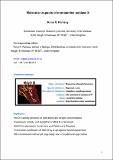Files in this item
Molecular aspects of monoamine oxidase B
Item metadata
| dc.contributor.author | Ramsay, Rona Ruth | |
| dc.date.accessioned | 2017-02-17T00:32:44Z | |
| dc.date.available | 2017-02-17T00:32:44Z | |
| dc.date.issued | 2016-08-01 | |
| dc.identifier | 241020143 | |
| dc.identifier | 3d73bef2-05d2-4a3b-bcae-36c04fc06e15 | |
| dc.identifier | 84975709281 | |
| dc.identifier | 000376204500010 | |
| dc.identifier.citation | Ramsay , R R 2016 , ' Molecular aspects of monoamine oxidase B ' , Progress in Neuro-Psychopharmacology & Biological Psychiatry , vol. 69 , pp. 81-89 . https://doi.org/10.1016/j.pnpbp.2016.02.005 | en |
| dc.identifier.issn | 0278-5846 | |
| dc.identifier.uri | https://hdl.handle.net/10023/10312 | |
| dc.description.abstract | Monoamine oxidases (MAO) influence the monoamine levels in brain by virtue of their role in neurotransmitter breakdown. MAO B is the predominant form in glial cells and in platelets. MAO B structure, function and kinetics are described as a background for the alterations in its activity on behavior. The need to inhibit MAO B to combat decreased brain amines continues to drive the search for new drugs. Reversible and irreversible inhibitors are now designed using data-mining, computational screening, docking and molecular dynamics. Multi-target ligands designed to combat the elevated activity of MAO B in Alzheimer’s and Parkinson’s Diseases incorporate MAO inhibition (usually irreversible) as well as iron chelation, antioxidant or neuroprotective properties. The main focus of drug design is the catalytic activity of MAO, but the imidazoline I2 site in the entrance cavity of MAO B is also a pharmacological target. Endogenous regulation of MAO B expression is discussed briefly in light of new studies measuring mRNA, protein, or activity in healthy and degenerative samples, including the effect of DNA methylation on the expression. Overall, this review focuses on examples of recent research on the molecular aspects of the expression, activity, and inhibition of MAO B. | |
| dc.format.extent | 9 | |
| dc.format.extent | 648635 | |
| dc.language.iso | eng | |
| dc.relation.ispartof | Progress in Neuro-Psychopharmacology & Biological Psychiatry | en |
| dc.subject | Monoamine oxidase B | en |
| dc.subject | Kinetics | en |
| dc.subject | Drug design | en |
| dc.subject | Neurotransmitter levels | en |
| dc.subject | Platelet | en |
| dc.subject | RC0321 Neuroscience. Biological psychiatry. Neuropsychiatry | en |
| dc.subject | QH301 Biology | en |
| dc.subject | Biochemistry, Genetics and Molecular Biology(all) | en |
| dc.subject | Biological Psychiatry | en |
| dc.subject | Cellular and Molecular Neuroscience | en |
| dc.subject.lcc | RC0321 | en |
| dc.subject.lcc | QH301 | en |
| dc.title | Molecular aspects of monoamine oxidase B | en |
| dc.type | Journal item | en |
| dc.contributor.sponsor | European Commission | en |
| dc.contributor.sponsor | The Royal Society of Edinburgh | en |
| dc.contributor.institution | University of St Andrews. School of Biology | en |
| dc.contributor.institution | University of St Andrews. Biomedical Sciences Research Complex | en |
| dc.identifier.doi | 10.1016/j.pnpbp.2016.02.005 | |
| dc.description.status | Peer reviewed | en |
| dc.date.embargoedUntil | 2017-02-16 | |
| dc.identifier.grantnumber | oc-2010-2-8526 | en |
| dc.identifier.grantnumber | N/A | en |
This item appears in the following Collection(s)
Items in the St Andrews Research Repository are protected by copyright, with all rights reserved, unless otherwise indicated.

